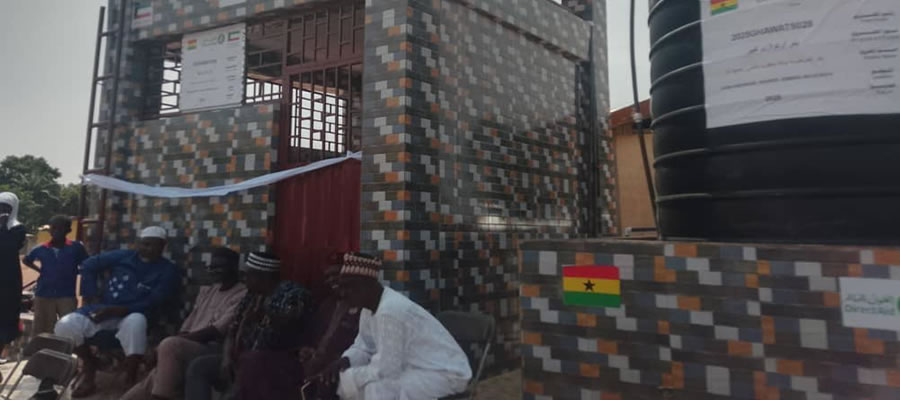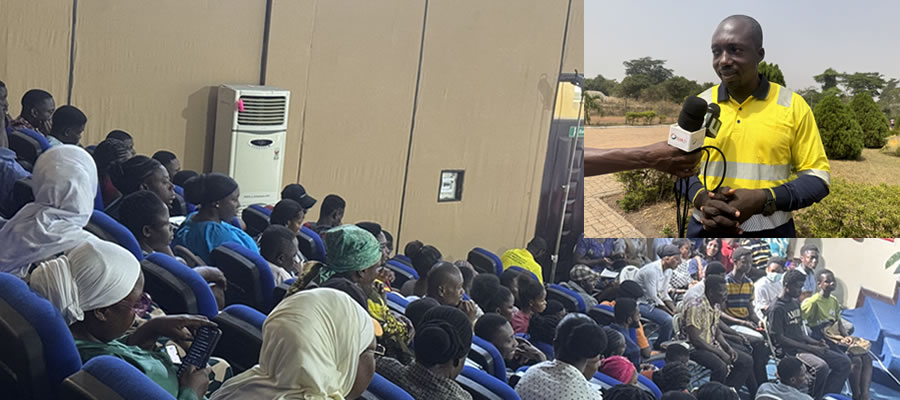

Agriculture stands to be the main stay of the Ejisu-Juaben Municipal economy by virtue of its percentage employment, which is 55.6% of the total employed labor force. It should be noted that about 87.2% of the farmers have their farms located within the Ejisu-Juaben Municipal with the remaining (12.8%) having theirs located outside the municipality.
Agriculture is however divided into two major types— crop farming and animal husbandry. The combination of these two activities gives rise to the third option—mixed farming. It was realized that majority of the farmers (94.1%) are into crop farming with the remaining 5.9% being mixed farming. This implies that none of the farmers were into only animal husbandry.
Crop Farming
The survey revealed that crop farming is the dominant agricultural activity in the Municipality. About 94.1 % of the farmers are into crop production. The favourable climatic conditions and the geophysical characteristics of the area support intensive crop farming. These and other factors such as the availability of arable lands account for the high crop production. Most of the food crops are grown mainly to be sold for income and the rest to be consumed by the family. Tree crops such as cocoa and oil palm are also grown mainly for commercial purposes.
Crops Cultivated
The major crops cultivated can be put into two categories:
Food crops: maize, plantain, cassava, cocoyam and vegetables
Tree crops: cocoa and oil palm
Farming Practices and Systems
The major farming practice in the Municipality is mixed farming (90.1% of the farmers). This implies that, whiles the farmers cultivate the food and tree crops, livestock and poultry are also kept in the backyard as a supplementary source of food and income. The remaining 9.9% of the farmers practice mono cropping. Considering the farming systems, bush fallowing, which is a system whereby a land is left for a period of time to regain its fertility is being practice by 48.5% of the farmers.
The length of fallow period has been drastically reduced due to the growing population and the increasing demand for lands for uses other than agriculture. Continuous cropping is practiced by about 45.5% of the farmers. This can result in the lose of soil fertility and adversely affect output levels if measures are not put in place to retain the soil fertility in the course of continuous cropping. The other 6% of the farmers practice crop rotation.
Ownership of Land
Land ownership in the Municipality are basically three. These are family (inheritance), self or by hiring. Quite a significant percentage (54.5%) of the farmers use family lands. This is followed by those who own the land personally. They constitute 28.8% of the farmers. The rest (16.5%) resort to the last option, which is by hiring. However, the sizes of their farms are small and keep on reducing as a result of fragmentation due to increasing family sizes. This impedes efforts to enter large-scale production.
Farm Size
The size of a farm can be said to be a determinant of the total output. The average farm size is 10.6 acres. The survey indicates that over 80% (81.2%) of the farmers cultivate less than 10acres and this, as said earlier, reflect the existing low output levels. It also impedes effort to commercialize production.
Farm Financing and Labour
Farmers in the Municipality finance their activities through three major ways. Most (88%) finance theirs through personal savings whiles 3% obtain moneys from money lenders. The remaining 9% obtain theirs through family members. The situation gives an idea of the number of farmers having access to credit. From the survey, it was realized that majority (87.2%) of the farmers do not have access to credit. This may be caused by lack of collateral, interest and the non-flexible repayment arrangements. Those who have access to a credit facility constitute 12.8% of the farmers.
But it was also further realized that 69.3% out of this have their access through the banks, with those farmers who have their access through co-operatives and individuals being 23.9% and 7.8% respectively. Considering the kind of labour force used for farming, farmers mostly depend on hired labour (50.4%). This is followed by those who make use of their self labour. This constitutes 34.7% of the farmers. The remaining 12.9% of the farmers rely on their family labour.
Access to Extension and Vertinary Services
The survey also indicated that a large majority of the farmers do not use the services of Agricultural Extension Agents. Only 26.8% of the farmers use the services of Agricultural Extension Agents while the majority 73.2% did not. This situation is as a result of the inadequacy of extension officers (the frontline officers) who assist farmers to address emerging problems and introduce them to new techniques. With access to Vertinary services for those who practice mixed farming, the picture is still the same. Over 70% of the farmers do not use the services of Veterinary services to assist them in the rearing of their farm animals.
Animal Husbandry
From the survey, it was realized that no farmer was solely practicing animal Husbandry. But for those who practices mixed farming; the types of animal reared include sheep, goat and cattle. The systems employed in rearing of animals are mainly the intensive system where animals are kept in a confined area and fully fed and semi-intensive where animals are allowed to go out during the day and brought indoors in the evening. From the survey, it was realized that 60% of the farmers who practice mixed farming employed the semi-intensive system, with the remaining 40% getting into the intensive system of rearing the animals. This implies that many livestock farmers use the semi-intensive method while majority of the poultry farmers adopt the intensive system especially the commercial farmers.
Income Levels in Agriculture
According to the survey, there is a wide income distribution ranging from below five hundred thousand cedis to beyond three million cedis. But it was realized that majority of the farmers (69.3%) earn between five hundred and thousand to three million cedis (¢501, 000 -¢3,000,000), while 19.8% are earning three million cedis and over. The remaining 10.9% earn below five hundred thousand cedis. In line with this, one can say that the income distribution in the agriculture sector is highly centered within the range of five hundred and thousand to three million cedis. The average income of the sector is however two million and thirty-two thousand, five hundred and twenty-five cedis (¢2,032,525) per farming season.
Saving Pattern of Farmers
Over 55% of farmers have cultivated the habit of saving their income. But it was also realized that a significant portion (44.5%) of the farmers did not save their income. With those who save their income, 51.2% of them save their money at the various banks available, with 14.2% of them been the least save with the "susu" schemes. The third form of savings, which is personal savings, was patronized by 34% of the farmers who has cultivated the habit of saving.
Considering the amount saved per month by farmers, it was realized that farmers who save between the range of One hundred thousand to five hundred thousand cedis (¢100,000 -¢500,000) constitute 67.9% of farmers who save. The amount saved per month ranges from below one hundred thousand cedis (¢100,000) to beyond five hundred thousand cedis (¢500,000). About 21.5% of farmers save below one hundred thousand cedis per month. The least proportion of farmers save above five hundred thousand cedis (¢500,000). These farmers constitute 10.8% of the farmers who save. The average amount saved by the farmers per month is two million, ninety-four thousand, six hundred and ninety-six cedis (¢294,696).
Expenditure of Farmers
Money spent by farmers ranges from below five hundred thousand to above three million cedis (¢500,000 - ¢300,000+). Majority (74.2%) of the farmers spend between five hundred and one thousand to three hundred thousand cedis (¢501,000 - ¢300,000). This is followed by farmers who spent an amount below five hundred thousand cedis (¢500,000). They form 15.9% of the farmers. The least among them are those who spent above three million cedis (¢300,000) per. They constitute 9.9% of the farmers. The table 7 below shows the expenditure pattern of the farmers per season. The average amount spent per farming season is one million, three hundred and fifty-five thousand, five hundred and nineteen cedis (¢1,355,519).
Ministry of Food and Agriculture
The major areas of operation of the ministry in the municipality are:
• Crops Services
• Veterinary Services
• Extension Services
• Women in Agricultural Development
• Livestock Development
• Management Information System
• Monitoring and Evaluation
The sources of finance for the activities undertaken by the ministry in the district include:
• Government of Ghana (GOG)
• Agricultural Sub-Sector Development Programme (AGSSIP)
• Food and Agricultural Budgetary Support (FAB)
• District Assembly
Some of the major problems facing the ministry in its operation are:
• Insufficient motor-bikes for staffs
• Inadequate maintenance allowance
• Insufficient and untimely release of working funds.
The ministry is currently undertaking these activities to improve agricultural production in the Municipality.
Training of farmers on improved farming methods
Ensuring effective and efficient delivery of agricultural services to clients including women, the youth and the disadvantaged in the Municipality.
Advising farmers on the application and adoption of the appropriate technology with the objective of increasing their productivity, income and well being under sustainable environmental conditions.
Facilitating the development of private sector extension and farmer based organization development.
Demonstrate proven result of ON- Farm Adaptive Trails (OFAT) to farmers.
The major problems facing agricultural production in the Municipality include:
• High cost of land acquisition (land tenure system).
• High cost of production due to high cost of farm inputs.
• Lack of standardized pricing system for farm produce.
• Insufficient credit and loan facilities for farmers.
• Poor repayment of loans received by farmers.
• Lack of storage and processing facilities.
• Over dependence on rain-fed agriculture.
The future prospects of the ministry in the area of agricultural development include the following:
To liaise with relevant research and training institutions for information and assistance for the promotion of agriculture in the Municipality.
To ensure that agricultural development programmes and projects are implemented in accordance with the rules, regulations and quality standards of MOFA.
Ensure food security.
Reduction of poverty and wealth creation.
Higher employment in the agricultural sector in the Municipality.
Greater contribution of the sector to GDP, foreign exchange and government revenues.
Date Created : 11/27/2017 3:02:05 AM













 facebook
facebook
 twitter
twitter
 Youtube
Youtube
 +233 593 831 280
+233 593 831 280 0800 430 430
0800 430 430 GPS: GE-231-4383
GPS: GE-231-4383 info@ghanadistricts.com
info@ghanadistricts.com Box GP1044, Accra, Ghana
Box GP1044, Accra, Ghana